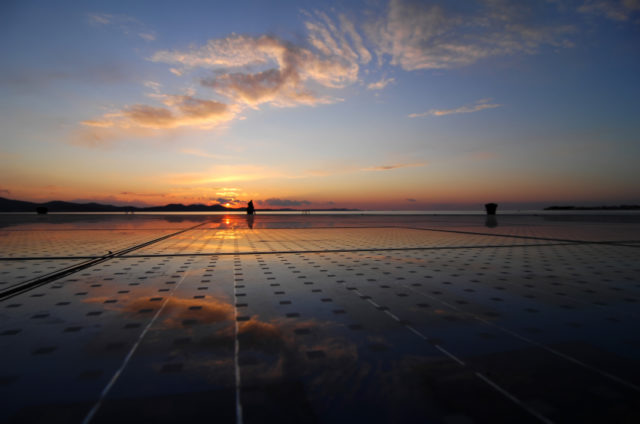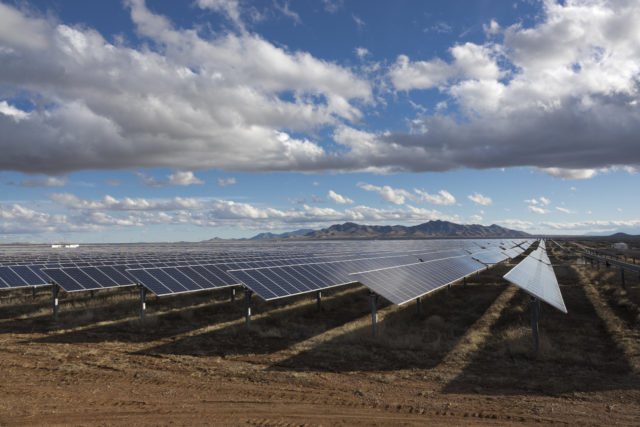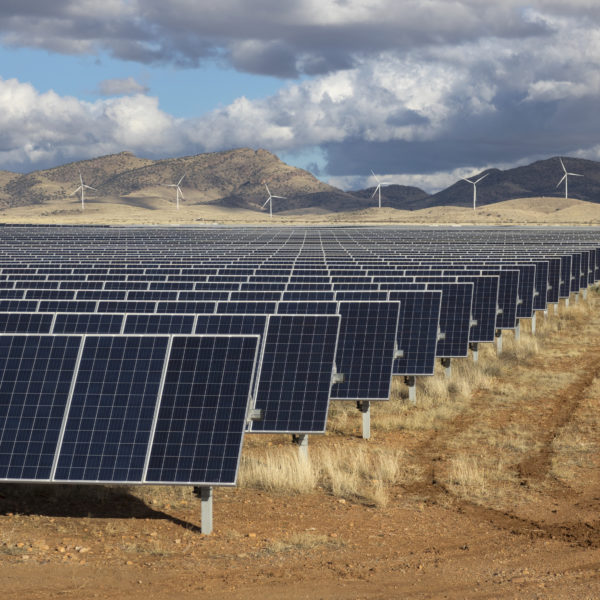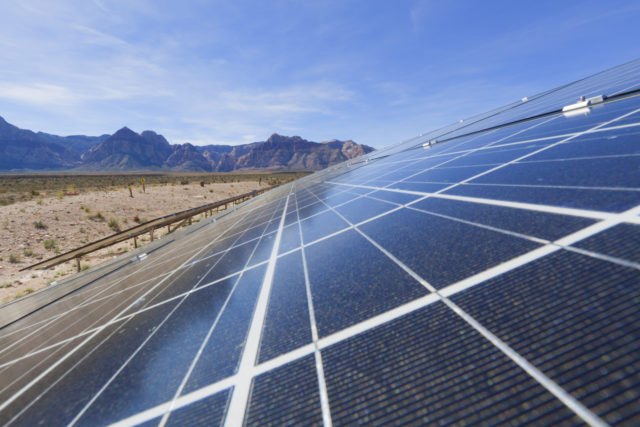“Under the Sonoran Institute’s approach, entities convene before a project even gets proposed, working on solutions to problems before they even surface.”
—Ian Calkins, Copper State Consulting
It was the environmental community’s dream—and its nightmare. Large-scale clean energy production in the West was finally feasible, but the sudden interest in developing it threatened millions of acres of unspoiled vistas, wildlife corridors, and habitat on public lands across the region.
“There was basically a land rush,” says Ian Dowdy, Sonoran Institute’s Sun Corridor program director. “Solar and wind power became this century’s gold.”
It all started with the Great Recession. As part of the infrastructure stimulus program in President Obama’s American Recovery and Reinvestment Act of 2009, the federal government offered guaranteed loans for renewable energy development. Large-scale solar energy projects suddenly began to pencil out and become very lucrative.
The Bureau of Land Management (BLM) was suddenly beset with applications for renewable development in every state, proposing development on large parcels of land—3,000 to 5,000 acres—many in the middle of pristine natural areas and places where habitat connectivity was essential. And because the land wasn’t designated or protected in any way, developers would be able to move forward for permits.
“It was a huge problem,” Dowdy says. “Building utility-scale solar and wind farms creates significant impacts on the land, and development in the wrong places would be disastrous.”
With the right approach, it was possible to avoid such disaster.
The BLM manages one in every 10 acres in the United States (blm.gov), and some are better for development than others. While many are beautiful, untouched, ecologically important public lands, others have been previously disturbed by mining, grazing, agriculture, or other uses. “A lot of the threat boiled down to developers not understanding the landscape and proposing siting on lands that had high conservation value when there were previously disturbed areas nearby,” Dowdy says.
Ideally, all the interested parties—the public land managers, energy interests, and conservationists—would come together to sort out and agree on the best places to locate projects. Vetting sites in advance would not only protect environmentally valuable lands but would also save developers time and money by expediting the review and approval of appropriately sited projects.
Here’s how the Sonoran Institute, using its trademark collaborative approach to conservation, convened these discussions and successfully advocated for environmentally sensitive solar and wind development.

The Western Solar Plan
As applications for permits for solar development inundated the BLM, it was clear that there was no way to conduct a thorough and adequate review of the projects to ensure that serious and long-term environmental harm would be avoided. “As a conservation community,” Dowdy says, “we raised our voices and said, ‘This cannot work.’”
The BLM recognized the problem and put a moratorium on solar applications. It embarked on the region-wide Western Solar Plan to identify the best places to locate utility-scale solar projects (100 megawatts or greater, or large enough to power approximately 65,000 homes or more) in six southwestern states: Arizona, California, Colorado, Nevada, New Mexico, and Utah.
Classifying these areas across tens of millions of acres would be a monumental task. To identify the most appropriate sites in Arizona, the Sonoran Institute stepped up to lend assistance.
“We want to see renewable energy replace fossil fuel extraction and high carbon emission energy production, provided it doesn’t destroy irreplaceable resources and compromise large landscape conservation,” Dowdy says. “We had recently worked to advance the Sonoran Desert Heritage Proposal, an effort to conserve valuable Arizona BLM lands, so we understood the lands being considered for development. In our view, the Western Solar Plan was an excellent opportunity to smartly site solar projects on these lands.”
To support this effort and help make the Western Solar Plan the best possible strategy for Arizona, the Sonoran Institute created a one-of-a-kind collaboration called the Arizona Solar Working Group, which allowed all parties to come together and collaborate. The Institute assembled a diverse group of representatives from Arizona’s major utilities, transmission line developers, and environmental and wildlife conservation organizations to discuss and agree on key elements of a successful solar development program on BLM lands in Arizona.
When it was ultimately approved in October 2012, the Western Solar Plan had identified about 285,000 acres of Solar Energy Zones across the six states and excluded about 79 million acres of land from utility-scale solar development.
“The Western Solar Plan was a huge process and a great example of collaboration to avoid conflict and allow an important use on federal lands,” Dowdy says.
Working Together to Fulfill Arizona’s Solar Potential
The Western Solar Plan was a great start. But, in Arizona, where abundant sunshine and vast, relatively flat expanses of land hold so much solar energy promise, the results were rather disappointing. Across the 12 million acres under management by the Arizona BLM (approximately 10-15 percent of the state), the Western Solar Plan had identified only two Solar Energy Zones.
Unsatisfied, BLM Director Ken Salazar directed his organization to dig deeper. It embarked on a new analysis for all of Arizona, called the Restoration Design Energy Project (RDEP). The Arizona Solar Working Group joined the initiative.
“The effort was really unprecedented, especially at this scale,” Dowdy says. “To identify all the areas statewide where solar development could happen was quite new but something the Sonoran Institute has advocated for a long time because it helps avoid conflict and is a more forward-looking, smarter way to enable land uses across large landscapes.”
“The Arizona Solar Working Group was instrumental in providing both data and comments on methodology on how we did that,” says Lane Cowger, project manager for the BLM. “The coolest thing about the working group is that they represent so much diversity but can still find common ground. That kind of feedback really helps us at the BLM when we’re doing our planning and project permitting.”
Completed in January of 2013, the RDEP process identified 290,000 acres of low-conflict sites for solar and wind development on Arizona BLM land, an additional 1.6 million acres of land across the state.
“The project has been held up as a great example of BLM doing planning the right way in involving the public and stakeholder groups on the front end and throughout the process,” Cowger says.

Getting Renewable Energy to Market
Finding low-impact sites to generate renewable energy is one challenge. Transporting it hundreds or thousands of miles, often from very remote areas to population centers without devastating the land and wildlife along the way, is another. As the BLM and U.S. Forest Service embarked on a review of federally designated “West-wide Energy Corridors” (WWEC), the Arizona Solar Working Group offered its assistance in providing a similar guided development approach to siting transmission infrastructure.
Reviewing the already designated WWECs and considering potential new corridors along low-conflict paths, the working group provided insights to help projects avoid such disputes in the future.
“In the old days, various entities would fight it out at the Arizona Corporation Commission in the final vote on a transmission project,” says Ian Calkins of Copper State Consulting Group. He is a member of the Arizona Solar Working group who represents non-utility developers of high-voltage, long-haul electric transmission projects. “Under the Sonoran Institute’s approach, entities convene before a project even gets proposed, working on solutions to problems before they even surface.”
All of the hard advance work is good for business, agrees Erik Bakken of Tucson Electric Power, another Arizona Solar Working Group member. “As a utility, we are all about low risk and certainty as we look to make major investments like transmission projects. To have consensus on identified corridors before moving forward is a tremendous benefit and surely goes a long way toward reducing some of the risk and adding certainty to that process.”
“Renewable-Ready”
Nearly a decade of work on siting clean energy projects has produced impressive results. The Sonoran Institute and our partners have helped gain approval for seven major solar and wind projects, with the capacity to power more than 1.1 million homes in Arizona. Additionally, two transmission lines have made it through the approval process and are now looking for solar and wind developers to purchase access on their lines. Developers of another proposed transmission line are considering locating it within a West-wide Energy Corridor that’s located adjacent to an interstate highway, which would establish an important precedent within Arizona by collocating infrastructure to reduce impacts. All of the new transmission lines have the potential to bring solar and wind to markets in and outside of Arizona.
“As the cost of solar and wind power becomes even more competitive, Arizona is well positioned to capitalize on the Sonoran Institute’s investment in planning and siting,” says Dowdy. “Now we’re a renewable-ready state.”


